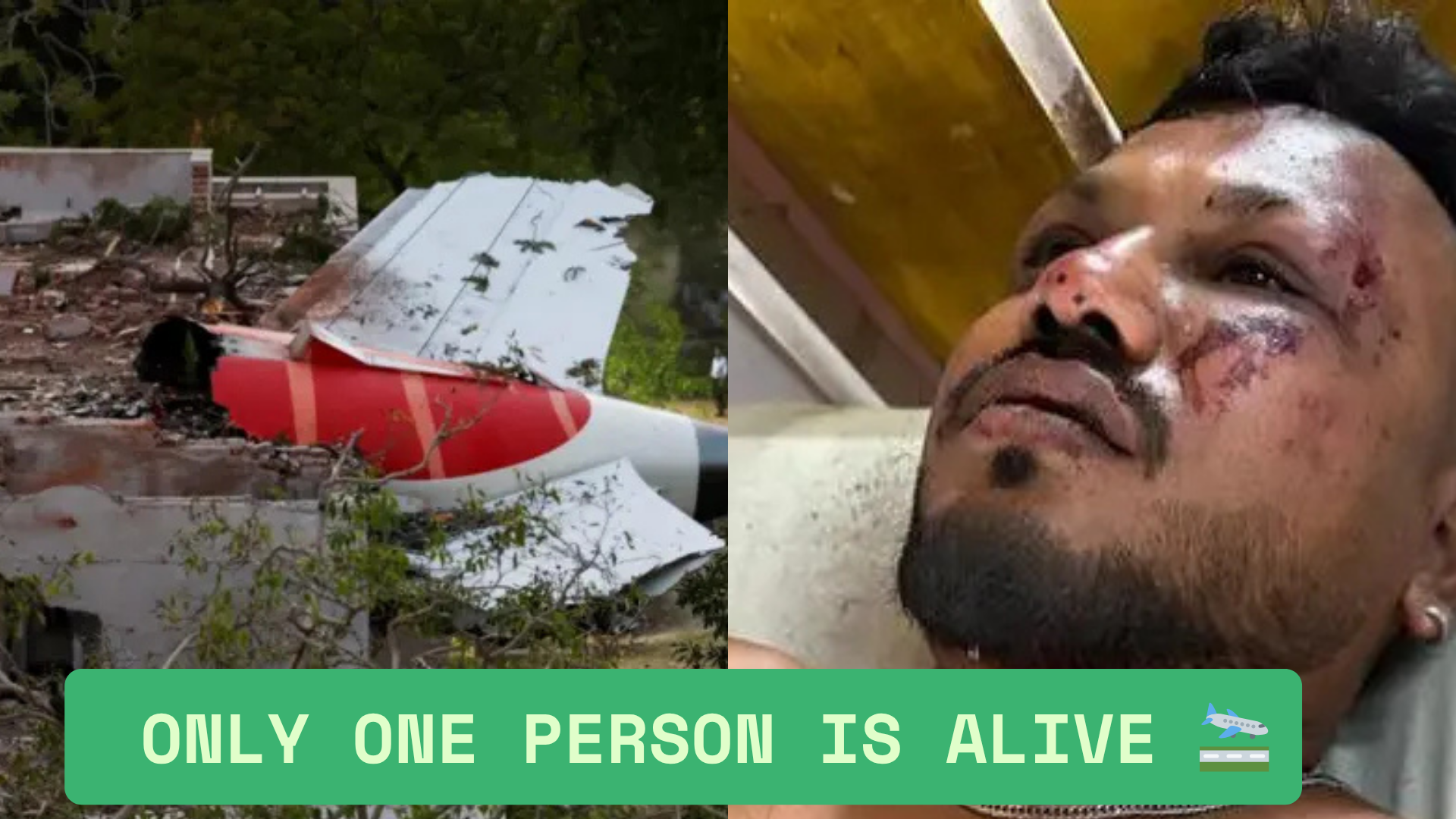Globa Now Contributor
The scorched remnants of Air India Flight AI117 still smolder in the heart of Ahmedabad. Where once there stood a doctors’ hostel, now lie twisted metal, charred trees, and shattered lives. The London-bound Boeing 787-8 Dreamliner, carrying 242 passengers and crew, crashed into the densely populated area just seconds after take-off, triggering one of the worst aviation disasters in India’s recent history.
Amit Shah (right) meeting Vishwashkumar Ramesh

At 13:38 local time (09:08 BST) on Thursday, what should have been a routine international flight turned catastrophic. Barely lifting off the tarmac of Ahmedabad’s Sardar Vallabhbhai Patel International Airport, the aircraft failed to gain altitude and veered into a residential neighborhood. In a matter of moments, a massive explosion erupted, setting buildings ablaze and sending plumes of black smoke curling high into the sky. Nearby residents captured dramatic footage of the jet’s final moments—its slow descent, the anguished cries, the fireball upon impact.
The Toll: A Nation Grieves
As night fell, rescue efforts turned grim. Emergency teams worked under the dim glow of portable floodlights, digging through the wreckage for survivors, though few were found. According to local police, at least 204 bodies have been recovered so far. The full extent of the toll is still unclear, with authorities unable to determine how many of the dead were aboard the plane versus on the ground when the aircraft slammed into the hostel.
Among the dead are believed to be medical students, some resting, others preparing for exams. More than 50 people are hospitalized with serious injuries—burns, fractures, and smoke inhalation among the most common.
The flight manifest revealed a diverse list of nationalities: 169 Indian citizens, 53 British nationals, seven Portuguese passengers, and one Canadian. Families across continents are now clinging to hope, many waiting in airports, others pacing in hospital corridors or huddled around televisions and phones.
A Lone Miracle: Vishwashkumar Ramesh
In the midst of this overwhelming tragedy, one story of survival has emerged—miraculous, bewildering, and tinged with sorrow. Vishwashkumar Ramesh, a British national originally from Leicester, is the sole known survivor from the aircraft. He was discovered amidst the rubble, bloodied but conscious, and rushed to a local hospital where Indian Home Affairs Minister Amit Shah visited him late Thursday evening.
Speaking from his hospital bed, Ramesh reportedly said he had “no idea” how he managed to survive. His brother, Nayankumar, later shared the family’s disbelief from Leicester: “We were just shocked as soon as we heard it. He told us, ‘I don’t know how I exited the plane.’”
Another relative, Jay, said that Vishwashkumar had spoken to his father and was asking about his brother Ajay—believed to have also been on board the doomed flight. “He was covered in blood,” Jay said. “He has injuries on his face, but he’s alive. That’s all that matters right now.”
On the Ground: A Scene of Apocalyptic Destruction
Eyewitness accounts describe a nightmarish tableau in the crash zone. Acrid smoke chokes the air, even hours after the fires have been largely subdued. One tree remains upright but blackened, its top still smoldering. Another lies collapsed across a street, sparks flickering weakly from its trunk.
Dozens of emergency vehicles, fire brigades, ambulances, and military trucks crowd the narrow residential lanes, while distraught relatives roam the site, searching for answers—or closure.
“I’ve never seen anything like this,” said a local journalist on the scene. “This isn’t just a crash—it looks like a war zone. There are pieces of the aircraft embedded in buildings, scattered across rooftops, buried in rubble. It’s hard to believe this was once a calm, populated part of the city.”
Part of the plane’s tail section is still visibly wedged into the third floor of the hostel building. A massive hole yawns in its roof, while smoke-stained walls lean precariously. Firefighters continue to spray water into the skeletal remains of structures to prevent rekindling.
Global Response and Investigations
As news spread, shockwaves rippled across the world. In the UK, Prime Minister Keir Starmer called the crash “absolutely devastating.” Addressing reporters, he said, “I speak for the entire country in saying our thoughts are with everyone involved.” He confirmed a British investigative team had been dispatched to Ahmedabad to assist local authorities and urged concerned families to contact the Foreign Office for updates.

“The scenes emerging from Ahmedabad are horrific,” Starmer added. “Our support for the victims and their families will be unwavering.”
The United States has also offered aid, sending a team from the National Transportation Safety Board (NTSB) to work with Indian officials and Boeing representatives. A spokesperson for Boeing expressed “deep sorrow” and said the company was cooperating fully with investigators.
India’s Directorate General of Civil Aviation (DGCA) has grounded all Boeing 787-8 aircraft operated by Air India until further notice. Early reports suggest the aircraft may have experienced a catastrophic failure during take-off—either mechanical or pilot-related—but officials stress it’s too soon to confirm the cause.
Community Mourning and Candlelight Vigils
Across India, vigils have sprung up. In Patna and Siliguri, hundreds gathered with candles and garlands, offering prayers and moments of silence for the victims. Some held up signs with messages of solidarity: “Ahmedabad, We Stand With You” and “Rest in Peace, Beautiful Souls.”
The scenes were mirrored in Leicester and London, where members of the British-Indian community came together at temples and community centers, sharing grief and trying to make sense of the tragedy.
Survivor’s Guilt and Unanswered Questions
For Vishwashkumar Ramesh, the road to recovery—both physical and emotional—will likely be long. Survivors of aviation disasters often suffer profound psychological trauma, particularly when the death toll is so high. His relatives say he remains disoriented, trying to recall the sequence of events leading to his survival.
Getty Images

“He keeps asking about Ajay,” said his cousin Jay. “He remembers a loud bang, darkness, and heat. Then nothing until he woke up surrounded by debris.”
Authorities have not yet confirmed whether Ajay Ramesh was on the final passenger manifest, and DNA testing is ongoing for many of the recovered bodies due to the severity of burns.
A Nation in Mourning—and on Alert
India’s Prime Minister Narendra Modi issued a statement offering “deep condolences” to the families of the victims. “This is a moment of profound national grief,” he said. “Our rescue and medical teams are working tirelessly. We will ensure a thorough investigation and support for all affected.”
The Indian Parliament observed a minute’s silence on Friday morning. Meanwhile, questions are being raised about the safety record of Air India and its oversight mechanisms. Just last year, the airline had reported an uptick in maintenance issues related to its aging fleet—a concern that may now take on renewed urgency.
The tragedy has also highlighted the vulnerability of urban development near airports. The area into which the Dreamliner crashed was heavily built up, with narrow roads and minimal open space, making rescue efforts significantly more difficult.

The Road Ahead
As dawn broke over Ahmedabad, the full scale of devastation became visible. What had been homes and places of learning are now blackened ruins. Yet amidst the wreckage, stories of heroism—of neighbors helping strangers, of medics working through the night, of one man’s improbable survival—are beginning to emerge.
Rescue operations will continue in the coming days, though hopes of finding additional survivors have faded. For now, the focus shifts to identification, support for grieving families, and a rigorous search for the truth behind this horrifying event.
As investigators comb through flight data recorders and cockpit voice tapes, one question echoes louder than the rest: how did a state-of-the-art Dreamliner, operated by India’s flagship carrier, fall from the sky just moments after take-off?
In the coming weeks, the world will demand answers. For now, Ahmedabad mourns.
Conclusion
The Air India crash in Ahmedabad is a harrowing reminder of the fragility of life and the devastating impact a single moment can have on hundreds of families across the globe. With over 200 lives lost, including students, professionals, and travelers from multiple nations, the tragedy has sent shockwaves far beyond India’s borders. While one man’s miraculous survival offers a sliver of hope, it also highlights the randomness and brutality of fate.
As investigations unfold and the global community rallies in support, this disaster leaves behind pressing questions—not just about aviation safety, but also about urban planning, crisis response, and the systems meant to protect lives in the sky and on the ground. For now, the focus remains on the victims, their grieving families, and a city left to mourn and rebuild. Amid the wreckage and sorrow, the world watches—united in grief, and demanding answers.




One thought on “Air India Plane Crash Kills Over 200; One British Passenger Survives”